| Day 1 Beijing, Lhasa ( ) |
| Be met at Lhasa airport by our English-speaking tour guide & transferred to your hotel. Free at leisure to acclimatize yourself to the high latituder. |
| Lhasa | Lhasa has an elevation of 3650 meters and sits at the center of the Tibet Plateau. It has a history of more than 1300 years. It towers as a huge magnet attracting those who want to explore its culture. Entry into Lhasa allows each traveler the chance to glimpse into Tibet. |
|
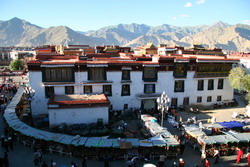 |
| [ Optional ] Ramoche Monastery: it is one of the key cultural relic protection sites in Lhasa, located on the north of Barkhor Street, in the area with a local market and many traditional style Tibetan style civilian houses. |
|
| Day 2 Lhasa ( B,L ) |
| Explore the famous attractions in downtown Lhasa today. |
| The Barkhor Street | The Barkhor Street is Lhasa's inner pilgrim circuit shaped roughly like an octagon that runs around the Jokhang. The circuit is lined with markets, shops, stalls and street vendors providing every conceivable item a Tibetan could need. The best place to start the circuit is right outside the Jokhan…… | | The Jokhang Temple | The Jokhang Temple is the spiritual centre of Tibet - a destination for millions of Tibetan pilgrims. The oldest part of the temple dates back to the 7th century AD - being one of the two temples built by King Songsten Gampo to house the statues of the Buddha that his two foreign wives brought to Ti…… | | The Potala Palace | The Potala Palace is a landmark of Lhasa and Lama Buddism. It is a 13 storey and 1000 rooms' palace and once winter residence of the Dalai Lama. The construction of the present structure began during the reign of the fifth Dalai Lama in 1645 and took more than 50 years to complete. |
|
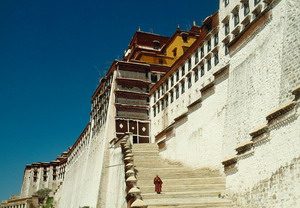 |
| [ Optional ] Tibetan Family Visit: Every Tibetan family has been either directly or indirectly affected by the Chinese, Indian and Nepal culture. Family life is one of the most interesting attractions during your stay in Tibet. Common Tibetan people welcome you to their homes, greet you in their traditional way and entertain you with their typical food. |
|
| Day 3 Lhasa ( B,L ) |
| Today's visit is a type of exploring the ancient Tibetan culture, should not be missed in Lhasa. |
| The Tibet Museum | The Tibet Museum, located in the southeastern corner of Norbu Lingka, Lhasa, is the first of its kind in Tibet to be provided with the latest in equipment and facilities. The Tibet Museum was completed and opened in October 1999. | | Norbulingka | The Norbulingka Park: Norbulingka means "Jeweled Garden". It was constructed as a summer palace for the Dalai Lama at the very beginning and later served as the whole governmental administration. | | The Sera Monastery | The Sera Monastery lies on the northern edge of Lhasa at the base of Tatipu Hill. 'Sera' means 'merciful hail' denoting its rivalry with the 'Rice Heap' (Drepong) since hail destroys rice. Sera was smaller than Drepong with about 7,000 monks but was very rich and comparable in power. |
|
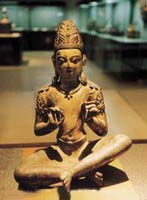 |
| [ Optional ] Lhasa Carpet Factory: Lhasa Carpet Factory is a factory south of Yanhe Dong Lu near the University of Tibet in Lhasa the capital of Tibet. It produces traditional Tibetan rugs. The highland of Tibet is the actual home of the oriental carpets. By visiting Carpet Factory you will have a general idea of how carpets are produced. |
|
| Day 4 Lhasa, Gyantse, Shigatse ( B,L ) |
| Drive to Shigstse, via from Yamdrok Tso to Gyantse (about 380km, 6 hours), have a picnic at the Yamdork Lake. Then drive to visit Kumbum Stupa & Pelkor Chode Monastery in Gyantse. Later transferred to Shigatse (about 90km, about 1 hours). Stay overnight in Shigatse. |
| Yamdroktso Lake | Yamdroktso Lake (4408 m), where you will enjoy the vista of its pincer-shaped expanse of turquoise water, with the mysterious Mt. Donang Sangwari (5,340m) on the peninsula beyond, and the snow peaks of Nojin Gangzang (7,191m) in the distance. You can walk around the lake before continuing our drive …… | | Dzong Fort | The Dzong Fort is localed on Dzong Hill, in the center of Gyantse. It was the office of the former local governmet of Gyantse. Dzong government of the feudal serf system is still well kept, giving visitors a better understanding of the serf system in old Tibet. | | Pelkor Chode Monastery & the Kumbum Stupa | Palkhor Monastery was founded in 1418. It houses both Pelkor Chode Monastery and the Kumbum Stupa, the world famous 9-storey 100,000-Buddha Pagoda with 9 floors, 108 doors and 77 rooms. Each room contains a different statue of Buddha and the wall frescoes tells the story. |
|
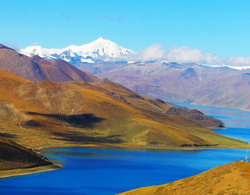 |
| [ Optional ] Karola Glacier: Go all the way up to climb up the top of the Gangba-La pass, stop at Yamdroktso Lake, suddenly you will meet Karola Glacier face to face. The Karola Glacier is quite close to the road, a breathtaking view of the Karola Glacier is an unforgetable experience. |
|
| Day 5 Shigatse, Lhasa ( B,L ) |
| Morning visit the Tashilungpo Monastery. Later drive back to Lhasa (about 280km, 3.5 hours). Check into the hotel. Free time for the last evening in Tibet. |
| Tashilhunpo Monastery | Tashilhunpo Monastery, the home of the Panchen Lama, is located on the hillside overlooking Shigatse northwest of the town. Tashilhunpo Monastery for the most part escaped the ravages of the Cultural Revolution and its chapels contain countless statues and mural decorated halls. It was established i…… |
|
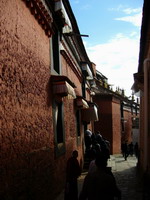 |
| [ Optional ] Tibetan Opera Performance: The Tibetan people are good at singing and dancing. Tibetan opera is called "Ajilamu" in Tibetan which means "sister fairy maiden". It is a kind of public square opera, which has play, vocal music, separate roles, accompanying band and special masks and clothes, and its main form is song and dance. |
|